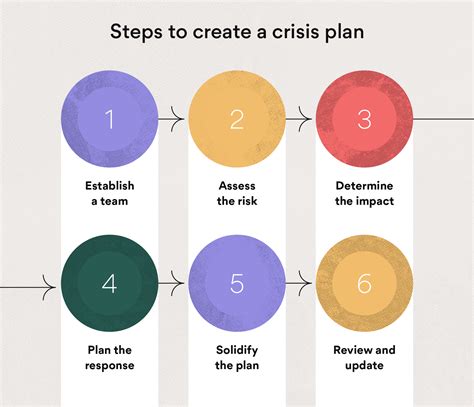In today’s ever-changing and unpredictable world, organizations of all sizes are vulnerable to potential crises that can disrupt operations, tarnish reputations, and even threaten their survival. This makes crisis management a crucial aspect of any business strategy. In this blog post, we will take a deep dive into the realm of crisis management, exploring the fundamental principles, strategies, and best practices that can help businesses navigate through turbulent times. From understanding the different types of crises to establishing effective communication strategies and implementing immediate response measures, we will cover all the essential aspects of crisis management. We will also delve into the importance of analyzing post-crisis lessons, building resilience and recovery strategies, and training and developing crisis management teams. Join us on this journey as we unravel the intricacies of crisis management and explore the ways in which organizations can effectively prepare for, respond to, and recover from crises.
Table of Contents
Understanding the Basics of Crisis Management
In crisis management, the primary goal is to minimize the negative impacts of a crisis and protect the organization’s reputation. This involves a proactive approach to preventing crises as well as a reactive plan for dealing with them when they do occur.
One of the key basics of crisis management is understanding the different types of crises that can affect an organization. These can include natural disasters, technological failures, financial crises, and reputational issues, among others. By identifying the potential types of crises, organizations can better prepare for how to respond in each scenario.
Another essential aspect of crisis management is preparing a comprehensive plan that outlines the steps and protocols to follow during a crisis. This crisis management plan should encompass the roles and responsibilities of key stakeholders, communication strategies, and resource allocation. It serves as a roadmap for navigating the chaos of a crisis.
In addition to having a plan in place, organizations must establish effective crisis communication strategies to ensure that accurate and timely information is conveyed to both internal and external stakeholders. This can help to maintain trust and transparency during a crisis.
Identifying the Types of Crises
In order to effectively handle crises, it is crucial to first understand the different types of crises that an organization may face. Identifying these types allows businesses to prepare and plan for the specific challenges that may arise. There are various categories of crises, including natural disasters, technological crises, financial crises, and organizational crises. Each of these types presents unique challenges and require different approaches to manage effectively.
Natural disasters such as earthquakes, hurricanes, and floods can cause widespread destruction and disruption to operations. Technological crises, on the other hand, may involve system failures, cyber-attacks, or data breaches that can compromise the security and integrity of the organization. Financial crises can stem from economic downturns, market crashes, or major financial losses, impacting the stability and viability of the business. Finally, organizational crises can include workplace accidents, product recalls, or leadership scandals that damage the reputation and credibility of the company.
By recognizing and understanding the specific types of crises that a business may encounter, leaders can develop targeted strategies and response plans. This proactive approach can minimize the impact of crises and mitigate potential damage. It also allows for clear and decisive actions to be taken in the face of adversity, ultimately protecting the organization and its stakeholders.
Furthermore, by identifying the types of crises, companies can also enhance their preparation and response mechanisms, as well as improve their communication strategies to address the specific needs of each type of crisis. This in-depth understanding creates a more resilient and agile approach to crisis management, ensuring that businesses are well-equipped to navigate the challenges that may arise.
Preparing a Crisis Management Plan
When it comes to preparing a crisis management plan, it is essential for organizations to take proactive measures in order to effectively respond to any potential crises that may arise. The first step in this process involves conducting a thorough risk assessment to identify and prioritize the most likely crisis scenarios that could impact the organization. By identifying the types of crises that could occur, the organization can then develop specific response strategies tailored to each potential scenario. This proactive approach allows the organization to be better prepared for any crisis situation that may arise.
Once the potential crisis scenarios have been identified, organizations can then begin to establish effective crisis communication strategies as part of their crisis management plan. Effective communication is crucial during a crisis, as it helps to maintain the organization’s reputation and credibility. This involves not only identifying key stakeholders and determining the most appropriate communication channels, but also developing clear and concise messaging that can be disseminated in a timely manner.
In addition to communication strategies, organizations must also implement immediate crisis response measures as part of their crisis management plan. This may involve activating an emergency response team, mobilizing necessary resources, or enacting specific protocols to mitigate the impact of the crisis. By taking swift and decisive action, organizations can effectively address the crisis and minimize its potential damage.
Finally, as part of preparing a crisis management plan, it is important for organizations to develop resilience and recovery strategies that can help them bounce back from a crisis situation. This may involve analyzing post-crisis lessons and improvements, as well as implementing measures to prevent a similar crisis from occurring in the future. By continuously monitoring and evaluating their crisis management performance, organizations can further refine their crisis management plan and enhance their overall preparedness for any potential crisis.
Establishing Effective Crisis Communication Strategies
Effective crisis communication strategies are essential for organizations to maintain their reputation and minimize the impact of a crisis. One key strategy is to establish clear and transparent communication channels to ensure that accurate information is quickly disseminated to employees, stakeholders, and the public. Utilizing various communication platforms such as social media, press releases, and direct messaging can help to reach a wide audience.
It is also crucial to designate spokespersons who are well-trained and equipped to handle media inquiries during a crisis. These individuals should convey a consistent message and tone to avoid confusion and misinformation. Additionally, creating crisis communication protocols and guidelines in advance can streamline the process and ensure a cohesive approach.
Another effective strategy is to actively listen to feedback and concerns from the affected parties. This demonstrates empathy and understanding, which can help to build trust and maintain a positive relationship with stakeholders. Furthermore, organizations should provide regular updates to keep stakeholders informed about the crisis management efforts and any developments.
Lastly, evaluating and adjusting communication strategies based on the feedback and outcomes of previous crises is vital for continuous improvement. By learning from past experiences, organizations can refine their approach and enhance their crisis communication effectiveness.
Assessing the Impact and Severity of a Crisis
When a crisis strikes, it is important for organizations to assess the impact and severity in order to effectively respond and mitigate the situation. The impact refers to the extent of the crisis’s effects on the organization, including the damage to infrastructure, financial loss, and harm to stakeholders. On the other hand, the severity relates to the level of intensity and potential long-term repercussions of the crisis.
Assessing the impact and severity involves conducting a thorough analysis of the crisis, including identifying the root causes, predicting the potential consequences, and evaluating the scope of the crisis. This assessment helps organizations to understand the magnitude of the crisis and make informed decisions on how to allocate resources and manage the situation.
Furthermore, assessing the impact and severity of a crisis also involves considering the emotional and psychological impact on individuals and communities affected by the crisis. It is essential for organizations to show empathy and support to those impacted, while also addressing any potential reputational damage that may arise.
In conclusion, assessing the impact and severity of a crisis is a critical part of effective crisis management. By understanding the full extent and potential consequences of a crisis, organizations can develop and implement appropriate response strategies to minimize the impact and facilitate recovery.
Implementing Immediate Crisis Response Measures
Implementing immediate crisis response measures is a critical step in managing any type of crisis. When faced with a crisis situation, it is important for organizations to act swiftly and decisively to minimize the impact and prevent further escalation of the crisis.
One of the first immediate crisis response measures is to establish a crisis management team and define their roles and responsibilities. This team should be equipped to make quick decisions and take necessary actions to address the crisis effectively.
Another essential measure is to communicate with all relevant stakeholders, including employees, customers, and the public, to keep them informed about the situation and provide guidance on how to respond. Clear and timely communication is crucial in implementing immediate crisis response measures.
Furthermore, organizations should be prepared to allocate resources and mobilize support to address the crisis promptly. This may involve coordinating with external agencies, activating contingency plans, and deploying crisis management tools and technologies to manage the situation.
Analyzing Post-Crisis Lessons and Improvements
After a crisis has passed, it is crucial for organizations to take the time to analyze and reflect on the lessons learned from the experience. By doing so, they can identify areas for improvement and develop strategies to prevent or better handle similar situations in the future.
During the analysis, it is important to consider all aspects of the crisis, including the response of the organization, the impact on stakeholders, and any communication challenges that were encountered. This comprehensive approach allows for a thorough understanding of the root causes of the crisis and provides valuable insights for making necessary adjustments moving forward.
Furthermore, the process of analyzing post-crisis lessons and improvements should involve input from all relevant parties within the organization. This may include management teams, communication specialists, and employees who were directly involved in the crisis response. By gathering diverse perspectives, a more holistic view of the situation can be obtained, leading to more effective solutions.
Ultimately, the goal of analyzing post-crisis lessons and improvements is to prevent similar incidents from occurring in the future and to ensure that the organization is better prepared to handle any potential crises that may arise. It is an essential part of the continual improvement process and contributes to the overall resilience of the organization.
Building Resilience and Recovery Strategies
Building resilience and recovery strategies is a critical aspect of crisis management. When a crisis hits, it’s important for organizations to have plans in place to not only weather the storm but to also bounce back stronger than before. Resilience refers to the ability to withstand and recover from adversity, while recovery involves the process of returning to a stable state after the crisis has passed.
One of the key components of resilience and recovery strategies is the development of contingency plans. These plans outline specific actions that need to be taken in the event of a crisis and can help minimize the impact of the crisis on the organization. It’s important for these plans to be flexible and adaptable, as each crisis is unique and may require different response measures.
Additionally, building resilience and recovery strategies involves identifying and mitigating vulnerabilities within the organization. This can include conducting risk assessments, strengthening infrastructure, and implementing backup systems to ensure that essential operations can continue even during a crisis. By identifying and addressing weaknesses before a crisis occurs, organizations can better position themselves to recover quickly and effectively.
Another important aspect of resilience and recovery strategies is the establishment of support systems. This can involve creating partnerships with external organizations, developing crisis response teams, and providing employees with training on how to respond in the event of a crisis. By building a strong support network, organizations can ensure that they have the resources and expertise needed to recover from a crisis.
Training and Developing Crisis Management Teams
One of the most crucial factors in successfully managing a crisis is having a well-prepared and highly capable crisis management team. These teams are responsible for making critical decisions under pressure and ensuring that the organization can effectively respond to any crisis situation.
First and foremost, training is essential for crisis management teams. This training should cover a wide range of potential crisis scenarios, ensuring that team members are prepared for anything that may arise. It’s important for team members to be well-versed in the organization’s crisis management plan and to understand their individual roles and responsibilities.
Additionally, developing these teams involves ongoing education and skill-building. It’s important for team members to stay up-to-date on best practices in crisis management, as well as any new developments in their respective fields. This may involve attending regular training sessions, workshops, and seminars to ensure that the team is well-equipped to handle any crisis that may come their way.
Furthermore, team building is an important aspect of developing crisis management teams. Building a sense of cohesion and trust among team members can be crucial in ensuring effective communication and decision-making during a crisis. Team-building activities and exercises can help strengthen these bonds and ensure that the team can work together seamlessly under pressure.
Monitoring and Evaluating Crisis Management Performance
Monitoring and evaluating crisis management performance is a critical step in ensuring that an organization is equipped to effectively handle any potential crises that may arise. By regularly assessing and analyzing the effectiveness of crisis management strategies, teams can identify areas for improvement and make necessary adjustments to better prepare for future crises.
One key aspect of monitoring and evaluating crisis management performance is the continuous review of crisis response protocols and procedures. This involves examining how well the organization’s crisis management team follows established protocols during a crisis, as well as identifying any gaps or deficiencies in the response process.
Additionally, the use of key performance indicators (KPIs) is essential for tracking and measuring the success of crisis management efforts. KPIs may include metrics such as response time, resolution rate, and stakeholder satisfaction levels. By regularly assessing these KPIs, organizations can gauge the effectiveness of their crisis management efforts and make informed decisions on areas requiring improvement.
Furthermore, conducting post-crisis debriefings and reviews is crucial for evaluating crisis management performance. These sessions provide an opportunity for the crisis management team to reflect on their response efforts, identify strengths and weaknesses, and develop action plans for improvement.





